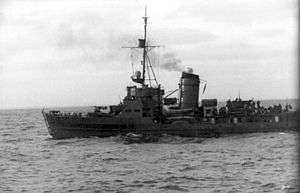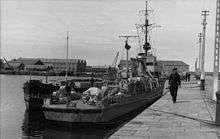M-class minesweeper (Germany)
 M1940 series minesweeper in 1941 | |
| Class overview | |
|---|---|
| Name: | M class |
| Operators: | |
| Subclasses: |
|
| Built: | 1937–1945 (not including older M1915 and M1916 ships) |
| Completed: |
|
| Lost: |
|
| General characteristics : M1935[1] | |
| Displacement: |
|
| Length: | 68.4 m (224 ft 5 in) |
| Beam: | 8.5 m (27 ft 11 in) |
| Draught: | 2.65 m (8 ft 8 in) |
| Propulsion: | 2 shaft VTE engines with exhaust turbines, 2 oil-fired boilers, 3,200 hp (2,386 kW) |
| Speed: | 18 knots (33 km/h; 21 mph) |
| Complement: | 113 |
| Armament: |
|
| General characteristics : M1940[2] | |
| Displacement: |
|
| Length: | 62.3 m (204 ft 5 in) |
| Beam: | 8.5 m (27 ft 11 in) |
| Draught: | 2.8 m (9 ft 2 in) |
| Propulsion: | 2 shaft VTE engines with exhaust turbines, 2 coal-fired boilers , 2,400 hp (1,790 kW) |
| Speed: | 16 knots (30 km/h; 18 mph) |
| Complement: | 80 |
| Armament: |
|
| General characteristics : M1943[3] | |
| Displacement: |
|
| Length: | 67.8 m (222 ft 5 in) |
| Beam: | 9 m (29 ft 6 in) |
| Draught: | 2.7 m (8 ft 10 in) |
| Propulsion: | 2 shaft VTE engines with exhaust turbines, 2 coal-fired boilers, 2,400 hp (1,790 kW) |
| Speed: | 16 knots (30 km/h; 18 mph) |
| Complement: | 107 |
| Armament: |
|
The M class were the standard minesweeper (German: Minensuchboot) of Nazi Germany's Kriegsmarine during World War II.
History
M1915 and M1916
A total of 36 old units from World War I served in World War II. Some of these were converted to experimental ships, artillery school ships, fleet tenders or R-boat tenders, and 1 (ex-M109) was converted into a survey ship. In 1940, most of these converted vessels were re-designated as minesweepers again.
M1935

The first series; the M1935 were ordered in the late 1930s to replace worn out World War I vintage boats. These ships proved versatile and seaworthy. The vessels could also undertake convoy escort, anti-submarine warfare and minelaying tasks as well as minesweeping. However, the ships were very expensive and complicated to build, and their oil-fired boilers meant they suffered from the fuel shortages in the later years of the war. A total of 69 ships were built in eight different shipyards, between 1937 and 1941. 34 were lost during the war.[4]
M1940
Although the M1935 was a very satisfactory vessel, it was complex and expensive to build and a simplified design was put into production in 1941. These ships had coal-fired boilers because of oil shortages. A total of 127 ships were built between 1941 and 1944, and 63 M1940 class ships were sunk during the war.[5]
In 1943, Romania built four modified M1940 minesweepers at the Galați shipyard, named the Democrația-class.[6][7]
M1943
This was a further simplified and slightly enlarged version of the M1940. These ships were designed for pre-fabrication and were produced in four versions:
- Minesweeper
- Anti-submarine vessel with extra depth charges
- Torpedo boat, with two 533 mm (21 in) torpedo tubes
- Torpedo training vessel
Only 18 vessels were completed by the time the war ended.[8]
Post-war

After the end of the war the surviving ships allocated to the United States, Britain and the Soviet Union. Many were assigned to the German Mine Sweeping Administration under British control to clear the coast of Northern Europe of mines. Several were later also given to France and Norway, and two to Italy.[9][10][11]
Eleven of the ships were returned to Germany in 1956/57 and were recommissioned into the Bundesmarine.
Fourteen M1940-type minesweepers (known as the Guadiaro class) were built for the Spanish Navy in Spanish shipyards. Seven of them were modernised with some help from the US Navy and served in the Spanish Navy for more than thirty years.
See also
- R boat, for smaller German minesweepers
- Sperrbrecher for another type of German World War 2 minesweeper
References
- Notes
- ↑ "Minensuchboot 1935 Technical Data". german-navy.de. Retrieved 10 September 2010.
- ↑ "Minensuchboot 1940 Technical Data". german-navy.de. Retrieved 10 September 2010.
- ↑ "Minensuchboot 1943 Technical Data". german-navy.de. Retrieved 10 September 2010.
- ↑ "Minensuchboot 1935 History". german-navy.de. Retrieved 10 September 2010.
- ↑ "Minensuchboot 1940 History". german-navy.de. Retrieved 10 September 2010.
- ↑ Frederick Thomas Jane, Jane's Fighting Ships, Volume 77, p. 275
- ↑ Robert Gardiner, Conway's All the World Fighting Ships 1947-1995, p. 326
- ↑ "Minensuchboot 1943 History". german-navy.de. Retrieved 10 September 2010.
- ↑ "Minensucher 1935 Ships". german-navy.de. Retrieved 10 September 2010.
- ↑ "Minensuchboot 1940 Ships". german-navy.de. Retrieved 10 September 2010.
- ↑ "Minensuchboot 1943 Ships". german-navy.de. Retrieved 10 September 2010.
- Bibliography
- Conway's All The World's Fighting Ships 1922-1946
- Online sources
- Mine hunter M1935, at German Navy website
- Mine hunter M1940, at German Navy website
- Mine hunter M1943, at German Navy website
Further reading
- Groener, Erich (November 1991). German Warships, 1815-1945: U-Boats and Mine Warfare Vessels (rev. ed.). Naval Institute Press. ISBN 978-1-55750-301-5. Retrieved May 6, 2014.